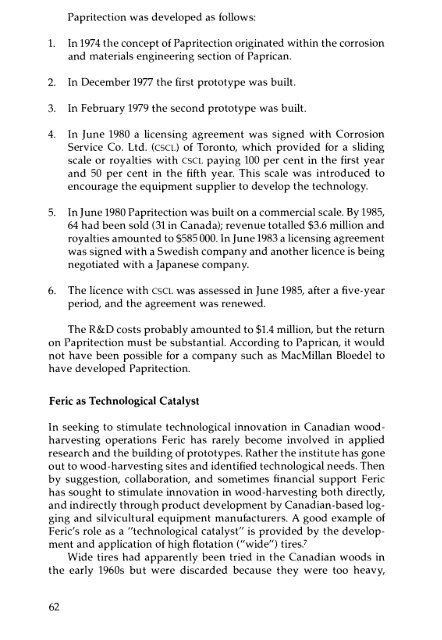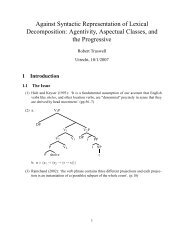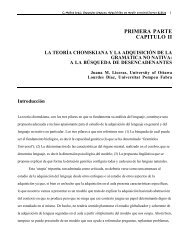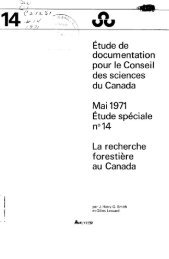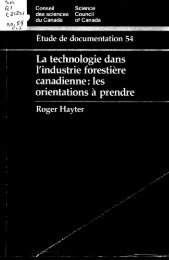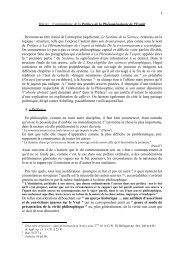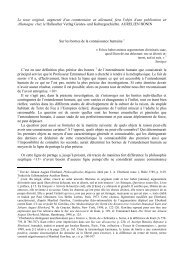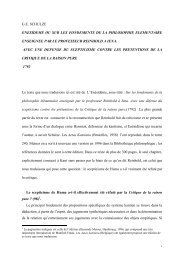Papritection was developed as follows:1. In 1974<strong>the</strong> concept of Papritection originated within <strong>the</strong> corrosion<strong>and</strong> materials engineering section of Paprican.2. In December 1977 <strong>the</strong> first prototype was built.3. In February 1979 <strong>the</strong> second prototype was built.4. In June 1980 a licensing agreement was signed with CorrosionService Co. Ltd. (CSCL) of Toronto, which provided for a slidingscale or royalties with CSCL paying 100 per cent in <strong>the</strong> first year<strong>and</strong> 50 per cent in <strong>the</strong> fifth year. This scale was introduced toencourage <strong>the</strong> equipment supplier to develop <strong>the</strong> technology.5. In June 1980 Papritection was built on a commercial scale. By 1985,64 had been sold (31in Canada); revenue totalled $3.6 million <strong>and</strong>royalties amounted to $585000. In June 1983 a licensing agreementwas signed with a Swedish company <strong>and</strong> ano<strong>the</strong>r licence is beingnegotiated with a Japanese company.6. The licence with CSCL was assessed in June 1985, after a five-yearperiod, <strong>and</strong> <strong>the</strong> agreement was renewed.The R&D costs probably amounted to $1.4 million, but <strong>the</strong> returnon Papritection must be substantial. According to Paprican, it wouldnot have been possible for a company such as MacMillan Bloedel tohave developed Papritection.Feric as Technological CatalystIn seeking to stimulate technological innovation in <strong>Canadian</strong> woodharvestingoperations Feric has rarely become involved in appliedresearch <strong>and</strong> <strong>the</strong> building of prototypes. Ra<strong>the</strong>r <strong>the</strong> institute has goneout to wood-harvesting sites <strong>and</strong> identified technological needs. Thenby suggestion, collaboration, <strong>and</strong> sometimes financial support Ferichas sought to stimulate innovation in wood-harvesting both directly,<strong>and</strong> indirectly through product development by <strong>Canadian</strong>-based logging<strong>and</strong> silvicultural equipment manufacturers. A good example ofFeric's role as a "technological catalyst" is provided by <strong>the</strong> development<strong>and</strong> application of high flotation ("wide") tires?Wide tires had apparently been tried in <strong>the</strong> <strong>Canadian</strong> woods in<strong>the</strong> early 1960s but were discarded because <strong>the</strong>y were too heavy,62
sluggish, <strong>and</strong> expensive. The potential advantages of using wide tireson logging machines, however, aroused renewed interest during <strong>the</strong>1970s as a result of environmental <strong>and</strong> silvicultural concerns, aninterest in reducing fuel consumption, <strong>and</strong> improvement in techniquesof, <strong>and</strong> materials for, manufacturing wide tires that were light,thin-walled but difficult to puncture. The events that led to commercialdevelopment of high flotation tires in Canada are as follows:1. In 1977 Feric investigated a novel off-highway carrier that haddistinctive drive <strong>and</strong> suspension characteristics <strong>and</strong> requiredlarge, high flotation tires. Feric decided <strong>the</strong> vehicle was unsuitable<strong>and</strong> that a more effective strategy would be to first develop a highflotation tire <strong>and</strong> <strong>the</strong>n develop an off-highway carrier.2. In 1979 Feric organized a worldwide search for a wide tire thatwould be adaptable to existing skidders. Various criteria, such astire width, flexibility, resistance, <strong>and</strong> design, were specified.Although established forest-machinery tire manufacturersremained sceptical, Feric eventually discovered a manufacturer inTexas, Rolligon, that made wide tires for geodetic purposes. Fericjudged <strong>the</strong> tires had potential, but Rolligon initially expressedlittle interest in modifying <strong>the</strong> tires for logging purposes.3. Notwithst<strong>and</strong>ing <strong>the</strong> lack of enthusiasm shown by industry, Fericpurchased five (modified) Rolligon tires in January 1980 to promote<strong>the</strong> development of wide tires for forestry purposes.4. In early 1980 Feric mounted <strong>the</strong> Rolligon tires on a John Deereskidder, which was <strong>the</strong> only existing model on which <strong>the</strong> tirescould be fitted easily. Field trials were conducted on <strong>the</strong> limits of<strong>the</strong> Spruce Falls Power <strong>and</strong> Paper Co. in <strong>the</strong> clay belt of nor<strong>the</strong>rnOntario. In return for <strong>the</strong> chance to be <strong>the</strong> first manufacturer, <strong>the</strong>American-owned John Deere lent Feric a machine <strong>and</strong> guaranteedfast service <strong>and</strong> a supply of spare parts.5. The results of <strong>the</strong> first field tests, <strong>and</strong> of subsequent tests in September<strong>and</strong> November 1980, revealed spectacular productivityincreases <strong>and</strong> minimal ground disturbance.6. In February 1981Feric, encouraged by <strong>the</strong> performance tests, organizeda meeting between equipment manufacturers, tire manufacturers,<strong>and</strong> logging development engineers to stimulate <strong>the</strong>commercial production <strong>and</strong> diffusion of wide-tire technology.63
- Page 3 and 4:
Science Council of Canada100 Metcal
- Page 5 and 6:
ContentsForewordAcknowledgments1113
- Page 7 and 8:
In-House R&D by Equipment Suppliers
- Page 9 and 10: Table 2.5: R&D Employment in 10 Can
- Page 11 and 12: ForewordTechnological innovation an
- Page 14 and 15: adapted sufficiently rapidly to the
- Page 16 and 17: Finally, the author interviewed sen
- Page 18 and 19: Table 1.3: Degree of Foreign Contro
- Page 20 and 21: Figure 1.1: Innovation Patterns and
- Page 22 and 23: Since 1945 the pace of technologica
- Page 24 and 25: Toward Reliance on Research rather
- Page 26 and 27: science occurred between 1900 and 1
- Page 28 and 29: Forestry Sector R&D SystemIn Canada
- Page 30 and 31: up its forestry research group at N
- Page 32 and 33: and one other that was strongly ori
- Page 34 and 35: closely involved in the establishme
- Page 36 and 37: to vet and control research priorit
- Page 38 and 39: In-House R&D by Equipment Suppliers
- Page 40 and 41: product. One, by no means atypical,
- Page 42 and 43: only internal source of dissolving
- Page 44 and 45: of which only 18 per cent came from
- Page 46 and 47: New information can be generated by
- Page 48 and 49: Chapter 3The R&D System andHow It W
- Page 50 and 51: Table 3.2: Summary Characteristics
- Page 52 and 53: Sixteen firms provided details on s
- Page 54 and 55: The Opco Process: A Case Study of I
- Page 56 and 57: however, within the last two decade
- Page 58 and 59: in 1959, and a full-scale experimen
- Page 62 and 63: Further tests were conducted in 198
- Page 64 and 65: fully automatic machines, and its s
- Page 66 and 67: Chapter 4Technological Capability a
- Page 68 and 69: Table 4.2 provides measurements of
- Page 70 and 71: forest-product equipment patents, w
- Page 72 and 73: Foreign-Ownership and In-House R&DT
- Page 74 and 75: Technological Liaisons: Forest-Prod
- Page 76 and 77: for this deficiency the federal gov
- Page 78 and 79: On the other hand, three of the lea
- Page 80 and 81: one of Sweden's forest-products gia
- Page 82 and 83: Capital Investments in the Canadian
- Page 84 and 85: and Quebec accounted for 33.9 per c
- Page 86 and 87: Table 5.5: Canadian Forest-Product
- Page 88 and 89: Scandinavian manufacturers are in t
- Page 90 and 91: was implemented smoothly and manage
- Page 92 and 93: the foundations were poured, until
- Page 94 and 95: inherent capabilities were never fu
- Page 96 and 97: especially in the east, has receive
- Page 98 and 99: "export staples mentality." The bel
- Page 100 and 101: size of the conglomerates would cer
- Page 102 and 103: the concept of flexibility explicit
- Page 104 and 105: This author therefore recommends th
- Page 106 and 107: with respect to technology transfer
- Page 108 and 109: of the R&D system and influence the
- Page 110 and 111:
operations, attitudes toward innova
- Page 112 and 113:
limited R&D base, but they do empha
- Page 114 and 115:
The small size and non-innovative n
- Page 116 and 117:
Promoting In-House R&D in the Fores
- Page 118 and 119:
Notes1. The Technological Challenge
- Page 120 and 121:
7. For example, nj. Daly, "Weak Lin
- Page 122 and 123:
7. P.G. Mellgren and E. Heidersdorf
- Page 124 and 125:
this R&D facility has become even s
- Page 126 and 127:
3. K. Noble, "Forest Industry Urged
- Page 128 and 129:
Publications of the ScienceCouncil
- Page 130 and 131:
Reports on Matters Referred by the
- Page 132 and 133:
No. 40. Government Regulation of th
- Page 134 and 135:
1981An Engineer's View of Science E


